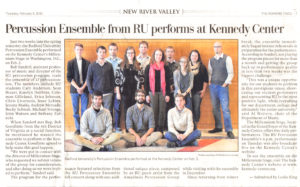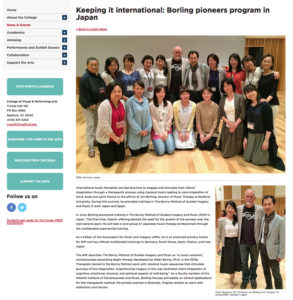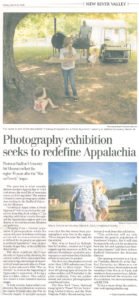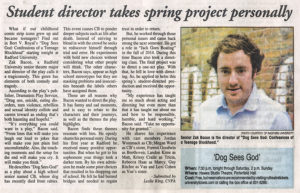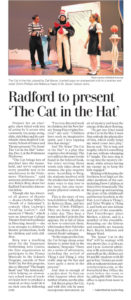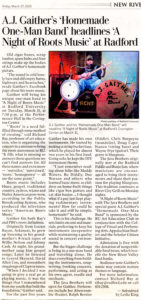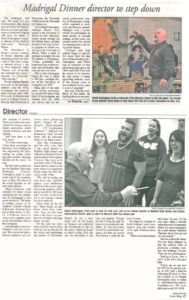 What: Media release for Madrigal Dinner events
What: Media release for Madrigal Dinner events
Who: Written for Radford University Department of Music
When: 2015
Where: Published in the New River Valley section of the Roanoke Times, Radford News Journal and the Radford University College of Visual and Performing Arts
Why: Part of the PR efforts for this event
The madrigals will sing. The jester will jest. Entertainment, fine dining and merriment will happen. But this is the last year audiences in Southwest Virginia will enjoy the labors of David Castonguay’s tenure as director of the Radford University Madrigal Dinner.
The Department of Music’s annual evenings of dinner, mayhem and Renaissance music are Dec. 4 and 5. This year’s dinner is centered on a skit by Paul Brandvik called “Dances with Windmills (an awkward love story),” inspired by Cervantes’ “Don Quixote.”
Though madrigal dinners are a part of the university tradition since the 1970s, Castonguay has produced these evenings since 1986. Previously, he directed and acted in madrigal dinners at Bemidji State University in Minnesota, the University of Illinois and the University of Connecticut.
According to Castonguay, madrigal dinners began at the University of Illinois in 1968. Their popularity spread throughout the United States, partially because of the large doctoral program in choral conducting at the University of Illinois. When a series of graduate assistants who ran the dinners in Champaign-Urbana graduated and taught at other colleges and universities, they took the idea with them.
This is how Castonguay began. He was a waiter in the first madrigal dinner at the University of Connecticut in 1970.
As part of the early music revival movement, he enjoyed the fruits of the labor of musicologists and scholars from the 1950s who delved into the historical performance practice of Renaissance music, which expanded to medieval and Baroque periods. Madrigals were a perfect vehicle for performance by small groups in intimate settings as entertainment outside the church for to the rising social classes.
“Colleges and high schools began to uncover this music from the dust bins of historical obscurity,” Castonguay said, “There was an explosion of new publications throughout the 1960s until 2000. Now with the advent of the Internet, the easy access to music typesetting software, much of this historic music is now available for free since it is out of copyright.”
But even with the free music, the madrigal dinner is an expensive program to produce. There are all the costs associated with doing a musical theatre production, which include costumes, sets and lighting.
And then there is the time aspect.
“It is time consuming … I have done everything for the show, from building the sets, engineering the lights, writing the scripts (stealing jokes mostly), directing the skit and the music,” he said.
But the future is unknown for the Radford University Madrigal Dinners. Castonguay plans to retire at the end of the academic year in May. The future of the event depends on the next choir director.
There is, however, a full schedule of choral events scheduled for the rest of Castonguay’s time at the university. The annual holiday concert at St. Andrews Catholic Church in Roanoke, featuring brass and all three choirs, is Dec. 12. In Feb., there is a concert of a cappella music at the Performance Hall in the Covington.
April heralds his last performance with the university. The concert includes a festival orchestra and university choirs performing Bach’s “Cantata 79” and Mozart’s “Missa Solemnis K. 337 ‘Archbishop Colleredo.’” Radford and Blacksburg High Schools choirs join the university choirs on the Bach cantata.
After this, Castonguay and his wife, Lois, who is the choral director at Radford High School and Dalton Intermediate School, plan to retire to Wallingford, Vermont. They have an eight-acre farm with a 1778 farmhouse and two barns in the town where it is legend that the first harvesting in the 1700s happened.
“We will be raising our own food (big vegetable garden, plant blueberries and revive the ancient apple trees on the property, which are at least 60 to 100 years old),” he said. On his to-do list is also buying a tractor for snow removal.
Other items on the list are, “Bake bread, can and freeze, brew beer, make cider. Hug my wife more times a day than I can now because we both work long hours,” he said.
For the past two summers, when he was not busy with his role as director for the visual and performing arts portion of Governors School, he put a new metal roof on the house in Vermont and solidified the one of the barn’s, which he hopes to finish in May 2016. He also ran electricity to the barn and painted. Though the list is long, he said the house is in exceptional condition. Previous owners were a renovation carpenter and then actress Mia Farrow’s sister for the past 19 years.
He hopes to continue to build furniture, teach voice lessons, sing and conduct if the right situation comes along.
“There is an EXTRAORDINARY ARTS SCENE!” he said, “In this rural state within a 60-mile radius there are 10 community choirs, two opera companies, the world famous Marlboro Chamber Music Festival, and two universities.”
But this is all in the future. For now, help celebrate his and the students’ effort in producing a holiday tradition, the Madrigal Dinners. There are two performances
Starting at 6 p.m., Dec. 4 and 5 at the Muse Banquet Hall.
Tickets are on sale now for $35 for the general public or $30 with a Radford University ID (limit 2). They are available at the Bonnie Information Desk or online at radfordactivities.universitytickets.com. For more information call (540) 831-5420.
